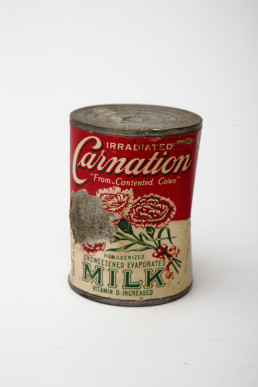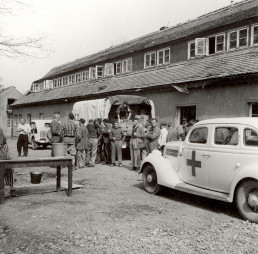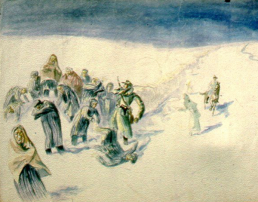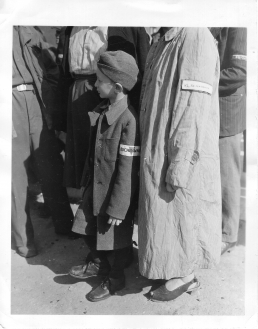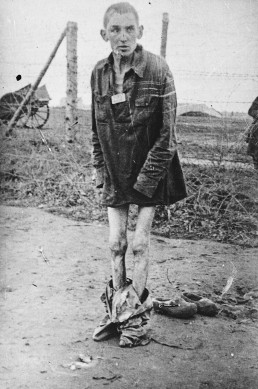Life in the liberated camp
Liberations
Many liberated prisoners were in a deplorable condition. Some were more dead than alive. Despite self-sacrificing help from US medics and civilian helpers, hundreds of people still died from the effects of imprisonment in Buchenwald and Mittelbau-Dora in the weeks after liberation. Some were unable to digest the fatty foods they had been given by the helpers.
At Buchenwald, the US troops moved the 900 or so liberated children and young people from the filthy camp barracks to better accommodations, many of them to the former SS buildings. International relief organizations and the US Army organized aid for the young survivors. The US military Rabbi Herschel Schacter stayed in the camp for months to care for the orphans and provide pastoral support.
The International Red Cross delivers medicine to the liberated Buchenwald camp, 17-18 April 1945.
In the first days after the liberation, there was an acute shortage of medical supplies. The seriously ill and starving children were supplied with medicine and food by the International Red Cross.
(Buchenwald Memorial)
American congressmen visit liberated prisoners in the former camp brothel, which was converted into a hospital ward, 21 April 1945.
(Buchenwald Memorial)
"At the time this unit took over the camp there were an estimated 21,000 prisoners there. The greatest problem facing the unit was one of sanitation. The water supply had been cut off due to the destruction of one of the mains by explosives. Latrine facilities in the camp were virtually non-existent and hygiene of any kind was apparently unknown. Prisoners' barracks were in the worst possible condition. Lighting was inadequate, barracks were filthy, barracks overcrowded, inmates underfed and underclothed. Upon taking over the camp, the unit began delousing and cleaning buildings which had formerly housed SS guards. As these buildings were cleared, the worst cases were transferred."
Excerpt from the report of the 120th US Evacuation Hospital, 10 June 1945.
The US liberators wrote a report on the disastrous sanitary conditions in the camp. They set up an emergency hospital.
(Buchenwald Memorial)
Jewish service in the cinema barracks at Buchenwald, 18 May 1945.
The US military chaplain Rabbi Herschel Schacter arrived at Buchenwald with the 3rd US Army on 11 April 1945, and remained there until June. He was especially committed to the Jewish orphans. The photo was taken at one of the services. The boy sitting in the front row with shorts is Robert Buechler. Sitting in front of the lectern, looking at the camera, is six-year-old Stefan Jakubowicz.
(Buchenwald Memorial)
"He arrived at Buchenwald as the first Jew, the Rabbi Schacter. He made ... it was the time of Passover or something. He distributed matzos, and he held services."
Jurek Kestenberg, in an interview with David P. Boder, recalls a service with Rabbi Schacter, 31 July 1946.
(„Voices of the Holocaust“, Illinois Institute for Technology)
"From floor to ceiling were hundreds upon hundreds of men and very few boys who were strewn over scraggly straw sacks looking down at me, looking down at me out of dazed eyes. [...] I remember their eyes, looking down, looking out of big, big eyes - that's all I saw were eyes - haunted, crippled, paralyzed with fear. They were emaciated skin and bones, half-crazed, more dead than alive. And there I stood and shouted in Yiddish "Sholem Aleychem, Yiden, yir zent frey!" "You are free." The more brave among them slowly began to approach me [...], to touch my Army uniform, to examine the Jewish chaplain's insignia, incredulously asking me again and again, "Is this true? Is it over?"
“You are free!” Report by Rabbi Herschel Schacter, 1981.
(Buchenwald Memorial)
Survivors of the Mittelbau-Dora Concentration Camp in a sanatorium in Sülzhayn (Harz Mountains), 29 June 1945.
The Americans brought several hundred survivors from the Mittelbau Concentration Camps to two sanatoriums in the spa town of Sülzhayn near Ellrich for recuperation. There, nurses from UNRRA (United Nations Relief and Rehabilitation Administration) cared for them.
(Photo: Edward Vetrone, NARA)
Liberations
Liberated in Buchenwald and Mittelbau Dora
In the fall of 1944, the SS began to clear the camps in the east. Tens of thousands of prisoners arrived at Buchenwald and Mittelbau-Dora on evacuation transports from Auschwitz and…
Liberated on death marches
As Allied troops approached in early 1945, the SS began to clear the first subcamps of the Buchenwald Concentration Camp, evacuating the prisoners to the main camp or to other camps.
Life in the liberated camp
Many liberated prisoners were in a deplorable condition. Some were more dead than alive. Despite self-sacrificing help from US medics and civilian helpers, hundreds of people still died…
Liberated on death marches
Liberations
As Allied troops approached in early 1945, the SS began to clear the first subcamps of the Buchenwald Concentration Camp, evacuating the prisoners to the main camp or to other camps. In early April, US troops advanced into Thuringia and the SS began evacuating the main camps at Buchenwald and Mittelbau-Dora. Some prisoners were evacuated by rail, but the SS also drove many of the exhausted prisoners on forced marches. Thousands of men, women and children died in the railway wagons, and even more on the death marches.
Some prisoners managed to escape during the evacuation transports. They hid and were liberated by US and Soviet troops.
Death march, escape, hiding. Magda Brown talks about her liberation in March 1945 in an interview, 2014.
Magda Brown (née Perlstein) was born in Miskolc (Hungary) on 11 June 1927. At the age of 17 she was deported to the Auschwitz Concentration Camp, then later that same year she was transferred to the Münchmühle subcamp as a forced laborer in an explosives factory in Allendorf, Hesse. The SS cleared the camp in March 1945, and the prisoners were marched to Buchenwald. During the march, the young woman managed to escape. She and 20 other women hid in a barn, where they were liberated by US soldiers.
(private property/magdabrown.com)
Photo of the barn where Magda Brown and other prisoners from the Buchenwald subcamp Münchmühle hid in 1945, after 1945.
After a day and a half in hiding, Magda Brown and the other women were discovered and liberated by two soldiers from the US Army’s 6th Armored Division.
(private property/magdabrown.com)
"No one yet understands that we have been left behind. There is really no one guarding us anymore! Halina and some girls decided to go to the village [...]. In the clearing lie the sick and weak women in blue-grey striped prisoners' clothes, the color of which clashes with this spring-like fresh green.
The girls return [...]. They are happy, smiling, screaming, crying with joy. THE END OF THE WAR!!! These most glorious words fall unexpectedly and gives strength.
The women run in different directions. They are free, free at last. I don't believe it yet. How did this happen? 'The Soviet army is in the village, we talked to the soldiers,' says a female comrade."
Maria Brzęcka recalls her liberation by Soviet soldiers on 5 May 1945, circa 1990.
Maria Brzęcka and her sister Halina were driven on a death march from the Meuselwitz subcamp toward the Czech Republic in mid-April 1945. Maria, who was completely exhausted, turned 15 while on the march. Shortly before reaching Prague, the SS guards ran off and the prisoners were free.
(Als Mädchen im KZ Meuselwitz – Erinnerungen von Maria Brzęcka-Kosk, Dresden 2016)
Notes written by Maria Brzęcka while on the death march, April/May 1945.
Maria Brzęcka noted the stations of the death march from Meuselwitz towards Prague.
(Buchenwald Memorial)
"Death March," watercolor painting by Polish-Jewish artist Walter Spitzer, 1945.
Walter Spitzer was born in Cieszyn on 14 June 1927. Deported from Poland, he arrived in Buchenwald on 10 February 1945 after a death march from Auschwitz via the Groß-Rosen Concentration Camp. The SS sent the 17-year-old on another death march on 7 April 1945. He managed to escape, and US soldiers liberated him near Jena.
(Ghetto Fighters’ House – Beit Lochamei HaGeta’ot)
US medical personnel treat an 18-year-old Soviet survivor of the Gardelegen massacre, April 1945.
SS members, Luftwaffe soldiers, and members of the Volkssturm and Reich Labor Service set a barn on fire on the outskirts of Gardelegen, murdering more than 1,000 concentration camp prisoners during the night of 13-14 April 1945. They were stranded in Gardelegen while on death marches from the Mittelbau-Dora Concentration Camp and camps in Hanover. Among those murdered were about 100 adolescents ; three sixteen-year-olds are known by name. Only a few prisoners survived the massacre.
(NARA)
Liberations
Liberated in Buchenwald and Mittelbau Dora
In the fall of 1944, the SS began to clear the camps in the east. Tens of thousands of prisoners arrived at Buchenwald and Mittelbau-Dora on evacuation transports from Auschwitz and…
Liberated on death marches
As Allied troops approached in early 1945, the SS began to clear the first subcamps of the Buchenwald Concentration Camp, evacuating the prisoners to the main camp or to other camps.
Life in the liberated camp
Many liberated prisoners were in a deplorable condition. Some were more dead than alive. Despite self-sacrificing help from US medics and civilian helpers, hundreds of people still died…
Liberated in Buchenwald and Mittelbau Dora
Liberations
In the fall of 1944, the SS began to clear the camps in the east. Tens of thousands of prisoners arrived at Buchenwald and Mittelbau-Dora on evacuation transports from Auschwitz and elsewhere. Among them were many children and adolescents.
In early April 1945, the US Army reached Thuringia. The SS began to clear out Buchenwald and Mittelbau-Dora. They sent almost 70,000 people on rail transports or forced marches to Dachau, Theresienstadt or Bergen-Belsen. Many did not survive.
On 11 April, American tanks reached the Ettersberg, forcing the SS to flee. Political prisoners took control of the camp. Buchenwald was thus liberated both from the outside and the inside. Among those liberated were nearly 900 children and young people.
In the southern Harz, the SS succeeded in completely clearing almost all of the Mittelbau concentration camps. Only in the Dora and Boelcke garrison camps were a few hundred sick and dying people left behind. They were liberated by the US Army on 11 April.
"What will happen then? Will we be evacuated? But where to? In the south they are approaching Halle.... To the north, another attacking force is approaching Hanover. Towards the east? Surely not far, because 300 kilometers from us is the Russian front. We are very afraid of the evacuation, because we know how those from Auschwitz and Groß-Rosen suffered during the transport."
Diary entry by Emile Delaunois, 1 April 1945.
The closer liberation came, the more uncertain the situation became for the prisoners. They feared death marches and massacres by the SS. Emile Delaunois (born Louis Lelong in 1910), was a clerk in the Woffleben subcamp of the Mittelbau-Dora Concentration Camp. He died shortly after liberation in the Bergen-Belsen Concentration Camp.
(Mittelbau-Dora Memorial)
Murdered prisoners in the north camp of the Ohrdruf subcamp, 6 April 1945.
In early April, the SS began to clear the Buchenwald subcamps . They sent the prisoners on transports back to the main camp. In several subcamps, such as Ohrdruf, they murdered those prisoners who were unable to march. US soldiers entered the camp on 6 April 1945.
(Buchenwald Memorial)
"The next day, the 10th of April, our complex was also to be evacuated. We hid wherever we could - in the hollow space between the boarding and cladding of the barrack wall, in the dark, musty and narrow space under the floor, under and in the stuffy straw sacks, or we squeezed ourselves into some stinking, vermin-infested sewage pit and refused to leave the block."
Account by Thomas Geve on his hiding place in Buchenwald's Little Camp, 1993.
The children and young people from Block 66 were also to be transported shortly before liberation. Many were able to hide and, like Thomas Geve (born Stefan Cohn in 1929), were liberated at Buchenwald on 11 April. Others were forced by the SS onto death marches, with a few escaping en route or being liberated by the Allies.
(Thomas Geve, Geraubte Kindheit, Constance 1993)
"Comrades, we have the camp in our hands!"
Account by Rolf Kralovitz of the liberation, 1995.
Rolf Kralovitz was 19 years old on the day of liberation and was in the main camp. In this interview he recalls how he perceived the liberation from “inside”.
(Buchenwald Memorial)
"When the door opened in the afternoon and two uniforms came in and these uniforms were different from the ones I was used to seeing for six years. But it is not only the uniforms, but the behavior of these two soldiers that made me understand that I was finally free. Tears of joy were then stuck in my throat."
Recollection by Leon Reich of his liberation in Buchenwald, 2015.
Unlike the prisoners in the main camp, the children and young people in Block 66 of the Little Camp saw little of what happened on the day of liberation. Leon Reich recalls this moment in an interview for the MDR film Die Kinder von Buchenwald (The Children of Buchenwald).
(MDR/Buchenwald Memorial)
Stefan Jakubowicz (now Stephen B. Jacobs) during a roll call after liberation, 1945.
On the day of liberation, Stefan Jacubowicz was five years old. He had been deported to Buchenwald with his father and brother in December 1944 and had survived thanks to the support of political prisoners in the Little Camp. In June 1945, he was brought to Switzerland with 300 other children as part of the Swiss relief operation. In 2002, he designed the memorial to the victims of the Little Camp at the Buchenwald Memorial.
(Buchenwald Memorial)
"There were still some able-bodied prisoners in the camp who had hidden in the infirmary before the camp was evacuated and now began to 'organize' something. They left the camp and brought back bread, milk, butter, bacon, potatoes, and even cigarettes they had found in a factory in Nordhausen."
Account by Roger de Coster, circa 1991.
The 16-year-old Belgian was one of about 80 prisoners liberated by US soldiers in the infirmary of the Dora camp on 11 April 1945.
(Mittelbau-Dora Memorial)
Liberations
Liberated in Buchenwald and Mittelbau Dora
In the fall of 1944, the SS began to clear the camps in the east. Tens of thousands of prisoners arrived at Buchenwald and Mittelbau-Dora on evacuation transports from Auschwitz and…
Liberated on death marches
As Allied troops approached in early 1945, the SS began to clear the first subcamps of the Buchenwald Concentration Camp, evacuating the prisoners to the main camp or to other camps.
Life in the liberated camp
Many liberated prisoners were in a deplorable condition. Some were more dead than alive. Despite self-sacrificing help from US medics and civilian helpers, hundreds of people still died…

